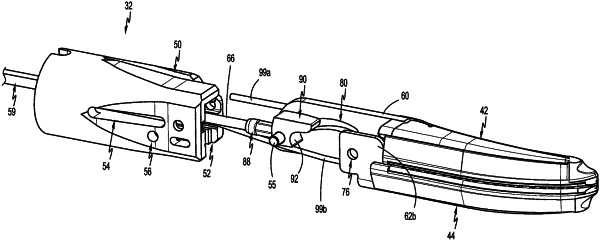| CPC A61B 34/70 (2016.02) [A61B 34/35 (2016.02); B25J 15/009 (2013.01); B25J 15/0028 (2013.01); B25J 15/0226 (2013.01)] | 20 Claims |

|
1. An end effector assembly of a robotic surgical instrument, the end effector assembly comprising:
a clevis;
a first jaw member pivotably coupled to the clevis via a pivot pin, the first jaw member defining a cam slot;
a second jaw member coupled to the clevis; and
a cam bar having a distal end portion received within the clevis, the distal end portion of the cam bar including a cam block supporting a cam pin, the cam pin received in the cam slot defined in the first jaw member, the cam block defining an upper surface, a lower surface, a pair of lateral side surfaces, and a distally-facing surface extending continuously between the upper and lower surfaces and between the pair of lateral sides, the distally-facing surface defining a cutout forming a concavity in the distally-facing surface configured to receive the pivot pin, wherein the cam bar is configured to move the cam block through the clevis to thereby move the cam pin through the cam slot to pivot at least one of the first or second jaw members relative to the clevis between a closed state in which the first and second jaw members are closer to one another, and an open state in which the first and second jaw members are further apart from one another.
|